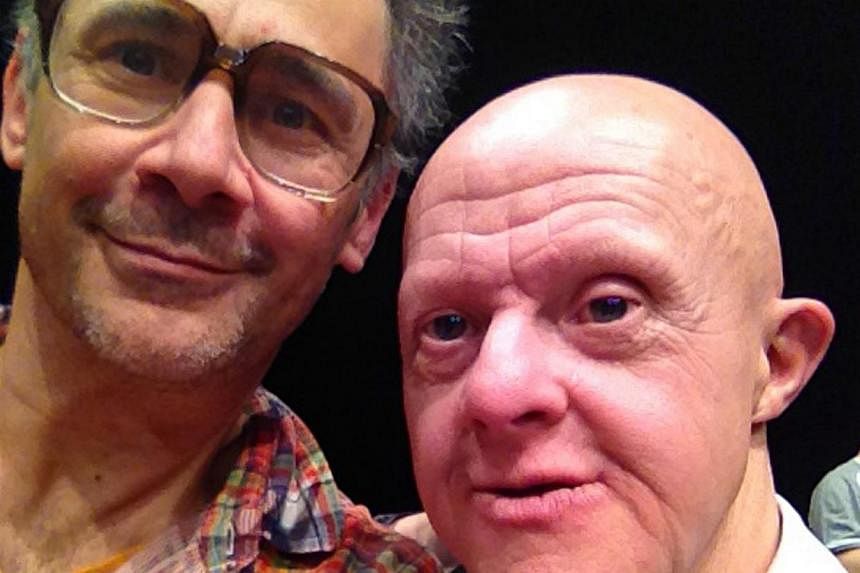In 2002, an audience member sued the International Dance Festival of Ireland for €38,000 over a performance of the eponymous work Jerome Bel.
The piece, which incorporated public urination and manipulation of genitals, was obscene and falsely advertised as dance, claimed Dublin businessman Raymond Whitehead.
Dance, Mr Whitehead wrote in a letter to The Irish Times, is "people moving rhythmically, jumping up and down, usually to music".
Ruffling feathers, not "moving rhythmically", is what Bel does best. The case against the festival was dismissed in 2004 and Bel's career has gone from strength to strength as he revels in playing the part of the enfant terrible and turning the notion of dance on its head.
The 49-year-old Frenchman's creations contain barely a step of what is traditionally conceived of as dance. In The Show Must Go On (2001), performers clapped headphones on their ears and bopped along to popular songs.
Shirtology (1997) is a multi-layered presentation - a single performer walks on stage buried in a multitude of shirts, which he slowly peels off one by one.
For Bel, the quality of movement is less important than the questions the movement throws up.
His idiosyncrasies also rear their head in how he eschews the usual stars of the stage for the underdogs, such as in the dance film Veronique Doisneau (2004).
During the creation of the performance, Bel was given access to all the dancers at the Paris Opera Ballet, but passed over the prima ballerinas to focus on the career of Doisneau, a 42-year-old member of the corps de ballet who was approaching retirement.
More recently, he has worked with Swiss company Theater Hora to produce Disabled Theater (2012), which will be performed here in September. In a democratisation of dance, the spotlight is shone not on professional dancers, but on performers with learning difficulties.
For someone whose practice veers far off the beaten path, Bel is surprisingly, well, normal.
A screening of Veronique Doisneau here last month by the organisers of the Singapore International Festival of Arts was followed by a video chat between the audience and Bel, speaking from his apartment in Paris.
The choreographer, all tousled hair and slightly scruffy, was effortlessly charming and down- to-earth.
After missing the first video call and then peering at the video stream sleepily - he apologised for it being early in Paris - Bel considered each question carefully and gave honest, unaffected answers.
His deft handling of the audience may arise from the fact that he began his career as a performer, not a creator. In 1984, he studied contemporary dance at the Centre Choregraphique National in Angers, and until 1991, danced for a variety of choreographers in France and Italy.
His transition from performer to creator came as he worked as assistant director for the opening ceremony of the 1992 Winter Olympics in France.
After he realised he preferred directing to performing, he took a two-year career break and emerged in 1994 with Nom Donne Par L'auteur (or in English, Name Given By The Author), which focused on everyday objects such as a vacuum cleaner and a hair dryer.
Since then, he has produced one work a year on average and his pieces have been performed in places such as Belgium, Thailand, London and New York.
You have said in interviews that calling you a choreographer is a misnomer. Why?
I am not a real choreographer as I don't create steps properly. My real job is to think about what can happen in a theatre. It can be texts, objects, films... movements too.
But dance is not the goal - it is a tool that I can sometimes use to articulate things.
Some of your works are provocative and a festival has even been sued for a performance of Jerome Bel. How do you feel about such strong reactions to your work?
I think it is great to produce strong reactions in the audience. I have no problem with this.
I am interested in the art which is challenging, the art which says or shows what people don't want to hear or see.
The history of the arts is full of rejection by the audience of the most important artworks, such as Van Gogh, Nijinsky and Stravinsky, John Cage, Pina Bausch, Beckett and Duras.
How do you select who to work with? Veronique Doisneau and Disabled Theater focus on people or groups of people who are ordinarily not in the limelight.
I select them precisely because they are not in the limelight. I show what is hidden, what society doesn't want to see.
I show the weakness of the minority against the power of the majority.
You have said in several interviews that you hate rehearsing and spending time with performers. Why?
Because it is boring to do the same things again and again. I have better things to do. This is the tradition of dance which is so alienating. That's why I don't rehearse.
I try things once and if it works, we don't do it again. If it fails, we don't do it again too.
You said: "It seems to me that there is only one type of theatrical practice possible for me, that is to say, the public performance", and in The Last Performance (2004), the names of people who have bought tickets are read out. Why is there such a large focus on the audience?
Because that's the goal of theatre. If I don't consider the audience, then I don't show my works - I do it for me alone. At a point in the process of the work, I question the relevance of presenting it to the audience. What is it producing on the audience? Is it constructive? How? What are the politics of the piece?
Then I start to change the work in order to give it to the audience.
Well, you have to know that I do public performances in order to save the world.
You receive many invitations to work with different groups. What was it about Theater Hora, a professional company of people with disabilities, that caught your eye?
When I first watched them, I couldn't believe what I was watching. Their ways of being on stage were so unique and rich that I could not not work with them.
What was your first impression when you met the performers in person? How did it change through the course of working with them?
I was very worried. I didn't know how to behave with them and it took me days to understand that they were very open to everything I could ask them to do. In fact, I could do whatever I wanted with them - they were never judgmental. It was fantastic.
I love to spend time with them - they are a great company. They give me something that no other group of people gives me. Their presence in the world is totally different and it is a real pleasure to share it.
Working with the disabled can be a sensitive issue and sometimes even the term "disabled" falls on the wrong side of political correctness. How do you deal with the sensitivity surrounding such performers?
To make a piece with them was very slippery.
Political correctness is awful. When I was thinking whether I should work with them, a lot of my friends were against it. And it is because of this fear that I decided to make the piece.
I realised it was a social and personal issue for a lot of people. It was mainly an issue of representation and in our society today, if you are not represented, you don't exist.
Mentally disabled people are hidden and this is a real problem because the less you know the other, the more you fear it. My job is to produce representation.
I was worried about the reception of the piece, but I knew I had to do it. And it turned out to be a great success. Of course, some audience members left the theatre. Some insulted me on Facebook, accusing me of exploiting them... but globally, it is a big success and they have been touring the whole world for two years now.
What keeps you awake at night?
Ideas for the pieces I am working on, solutions for the theatrical problems I encountered in the day.
What helps you get up in the morning?
All the things I want to experiment with during the day. In the morning, I don't want to work. I want to do other things - I want to read, watch movies, see exhibitions and, at night, go to see performances.
But then during that day, though I don't want to work, ideas come to me and they follow me until late at night.
I am a victim of my ideas, this strange unconscious energy which wants to get out of me.


